Porcelain Insulator News
by Elton Gish
Reprinted from "Crown Jewels of the Wire", July 2004, page 16
As I alluded to in the last PIN, a new and very exciting Fred Locke porcelain
insulator has surfaced. It has a very interesting story and an old faded
handwritten note to document where it was used. Mike Bliss said he got the
insulator from someone in his extended family that has had it for about 20
years. We don't know who wrote the note. The note came with the Xerox copies of
a page from the 1910 Locke catalog. From the look of the Xerox copies, I'm
certain they were made in the early 1970's. Here is the complete text of the
note:
This pin type insulator is a catalog No. 64 as shown in sheet 2800 of The
Locke Insulator Mfg. Co. catalog of 1910. It was manufactured at the Victor, NY
plant in 1905. For 34 years it was in service on a 23,000 volt system located in
Honolulu, T.H. Sea coast exposure subjected it to salt contaminants. In 1939,
this unit was removed from service and was returned to The Locke Insulator Co.
then located in Baltimore, Maryland. Examination and test of this unit showed
that it was in excellent condition being both mechanically and electrically
sound. Since 1939 this insulator has been maintained as a museum piece.
That is essentially all we know about the insulator. It was removed from a
line in Honolulu, Hawaii in 1939 and sent to the Locke factory in Baltimore
where it was preserved as part of their history. Apparently the later owner of
the plant, General Electric Co., removed all old pin-type insulators from the
factory when the manufacture of pin-type insulators was discontinued in 1971.
We know from the under-glaze ink marking that it was not manufactured at the
Victor plant in 1905. Under-glaze ink marked specimens were made by the Electric
Porcelain Mfg. Co. in Trenton, NJ from near the end of 1897 or January 1898 to
as late as 1900. EPMC was making only dry process porcelain insulators and
converted to making wet process porcelain insulators with the help of Fred
Locke. He had learned the technique from Imperial Porcelain Works and confirmed
in John Lapp's experimental kiln in the summer of 1897 at Honeoye Fall, NY. Much
more of the details can be found in my book, Fred M. Locke: A Biography.
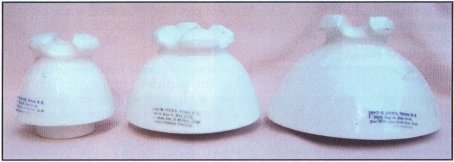
New Fred Locke insulator, U-927, (shown on the far right)
has #5-1 blue
under-glaze ink marking. For comparison, U-927 is shown with
U-939 (left) and U-927A (center).
Note that it is a 3-part glazeweld, which is composed of three shells fused
together with glaze. The specimen is very well made with a top firing rest. The
glazeweld joints are uniform as if extra glaze was used to fill in all the
gaps. I will not repeat the discussion of the Thomas lawsuit against Fred
Locke and EPMC for their infringement of the Boch glaze-filling patent.
Usually glazeweld specimens made at Fred Locke's Victor factory
show gaps in the glazeweld joint, but the glazeweld joint on U-927 is full of
clear glaze used to fuse the parts together.
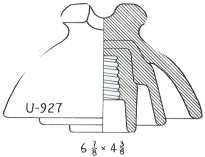
The earliest trade journal article I could find showing U-927 was one in the
March 4, 1899, issue of Electrical World. The latest advertisement was one in
the January 13, 1900, issue of Electrical World. The same photograph was
probably used in all the ads. Note that it was shown used with a white porcelain
pin base. Here is a similar photograph made with the U-927.
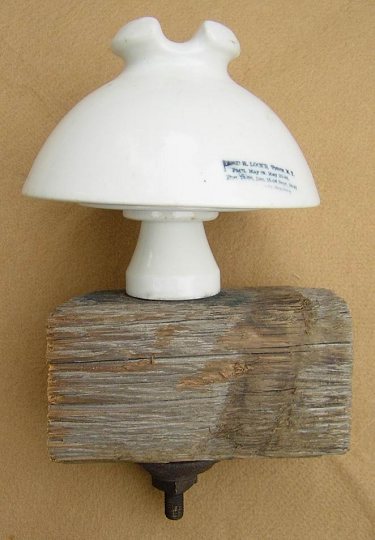
U-927 is shown complete with Fred Locke pin and glazed
porcelain pin base.
The Electric Porcelain Mfg. Co. at
Trenton, NJ made both the insulator and the
pin base for
Fred Locke. The pin base has recess-embossed marking #1-3.
As a side note, Fred Locke designed steel pins with threaded wood cob and
have the embossed marking on the top steel button, LOCKE'S / / PAT, in a circle
as shown in the photo below. I have several pins like this. Have you seen this
very early pin?
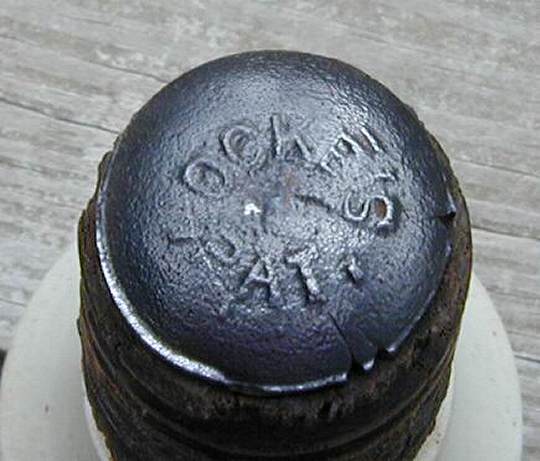
Below are photos from two of the trade journal articles. In the April 12,
1899, issue of Electrical Review, it stated, "Figure 2 shows a three-part
insulator, fused with glaze, designed to carry from 20,000 to 35,000 volts, and
which, it is said, will stand a salt water test of 80,000 volts. It is compact
in form, standard in quality and of large capacity. The insulator is 7" in
diameter, 4-1/2" high and weighs 3-3/4 pounds."
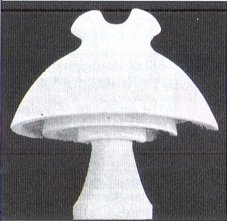
Fig. 2 3-Part
China Insulator.
Electrical Review,
April 12, 1899
The next two photos are from the March 4, 1898, issue of Electrical World.
(next page) The text describes the insulator as follows, "Another
three-shell china insulator is shown in Fig. 6. It is the No.4 style, and is
recommended for potentials as high as 60,000 volts. There are said to be 20,000
of them in use. Its diameter is 7 inches, and weight 4 pounds." The
"60,000 volts" claim must be a misprint. Don't think even Fred. Locke
would claim that unrealistic service. An interesting note here is that after
Fred Locke opened his own insulator plant in Victor, NY in the summer of 1898
and after he stopped having EPMC make insulators for him in the first half of 1900,
he replaced the No.4 Three-Part Porcelain Insulator with U-932. We showed this
insulator in the last PIN in the April issue of CJ. U-932 was a bit larger at
7-3/8" in diameter. It was shown in his No.5 catalog published in August
1900. The inner skirts extended down a bit more than in U-927.
Finally, some of you may wonder about the assignment of U-927. It is shown in
Jack Tod's Porcelain Insulator Guide Book. However, the drawing used for U-927
by Jack is not correct. From Jack's notes I knew the drawing was made based on a
style shown in an early Thomas catalog. After researching Thomas catalogs, it
became apparent that the drawing shown only in one Thomas catalog that Jack used
to make the drawing was not accurate. The catalog numbers confirmed the style
to be U-950, a two-part glazeweld. In CJ 1-80-32, Errol Bond reported having an
insulator similar to U-927 except it was shorter and had the Imperial crown and
wordy markings. In 1995, Errol showed me the specimen he reported. It actually
is U-927C, but much shorter at 3-5/8" tall compared to the drawing for U-927C
that is 4" tall. Bottom assignment of U927 is not valid. So, the reassignment of U-927 to the new
Fred Locke insulator fit well in the U-Chart as a 3-part glazeweld.
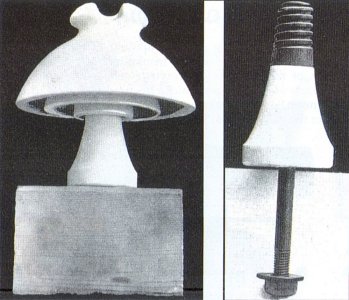
U-927 was shown in the March 4, 1899, issue of
Electrical World with Locke
pin and porcelain pin base.
| 